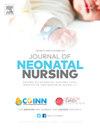使用迭代质量改进方法增加极早产儿和极早产儿的皮肤护理
Q2 Nursing
引用次数: 0
摘要
目的:本质量改善(QI)计划旨在将IV级NICU中妊娠32周婴儿的皮肤对皮肤护理(SSC)和积极父母接触(PPT)率提高到90%。方法在关键驱动图的指导下,通过三个计划-做-研究-行动(PDSA)周期实施干预措施:发育轮次(第1个月)、家长教育(第6个月)和支持和加强新生儿重症监护病房感觉体验计划(第8个月)。我们评估了出生后72小时内的PPT,出生后第一周内的SSC,以及在开发、实施和可持续性阶段首次SSC的时间。结果sssc率从71%(开发)上升到93%(实施)和94%(可持续性)。在实施和可持续性阶段,PPT率保持在98%。未观察到计划外拔管或脑室内出血的增加。结论采用结构化、多学科的方法可提高并维持早产儿SSC的发生率,且无不良反应。本文章由计算机程序翻译,如有差异,请以英文原文为准。
Increasing skin-to-skin care in very and extremely preterm infants using an iterative quality improvement approach
Objective
This quality improvement (QI) initiative aimed to increase skin-to-skin care (SSC) and positive parental touch (PPT) rates to >90 % among infants <32 weeks' gestation in a Level IV NICU.
Methods
Guided by a key driver diagram, interventions were implemented through three Plan-Do-Study-Act (PDSA) cycles: developmental rounds (month 1), parent education (month 6), and the Supporting and Enhancing NICU Sensory Experiences program (month 8). We evaluated PPT within 72 h of birth, SSC within the first week of life, and time to first SSC during the development, implementation, and sustainability phases.
Results
SSC rates increased from 71 % (development) to 93 % (implementation) and 94 % (sustainability). PPT rates sustained at 98 % during the implementation and sustainability phases. No increases in unplanned extubation or intraventricular hemorrhage were observed.
Conclusion
A structured, multidisciplinary approach improved and sustained SSC rates for preterm infants without adverse effects.
求助全文
通过发布文献求助,成功后即可免费获取论文全文。
去求助
来源期刊

Journal of Neonatal Nursing
Nursing-Pediatrics
CiteScore
2.00
自引率
0.00%
发文量
143
期刊介绍:
Aims & Scope: This is the practical, bimonthly, research-based journal for all professionals concerned with the care of neonates and their families, both in hospital and the community. It aims to support the development of the essential practice, management, education and health promotion skills required by these professionals. The JNN will provide a forum for the exchange of ideas and information between the range of professionals working in this field; promote cooperation between these professionals; facilitate partnership care with families; provide information and informed opinion; promote innovation and change in the care of neonates and their families; and provide an education resource for this important rapidly developing field.
 求助内容:
求助内容: 应助结果提醒方式:
应助结果提醒方式:


